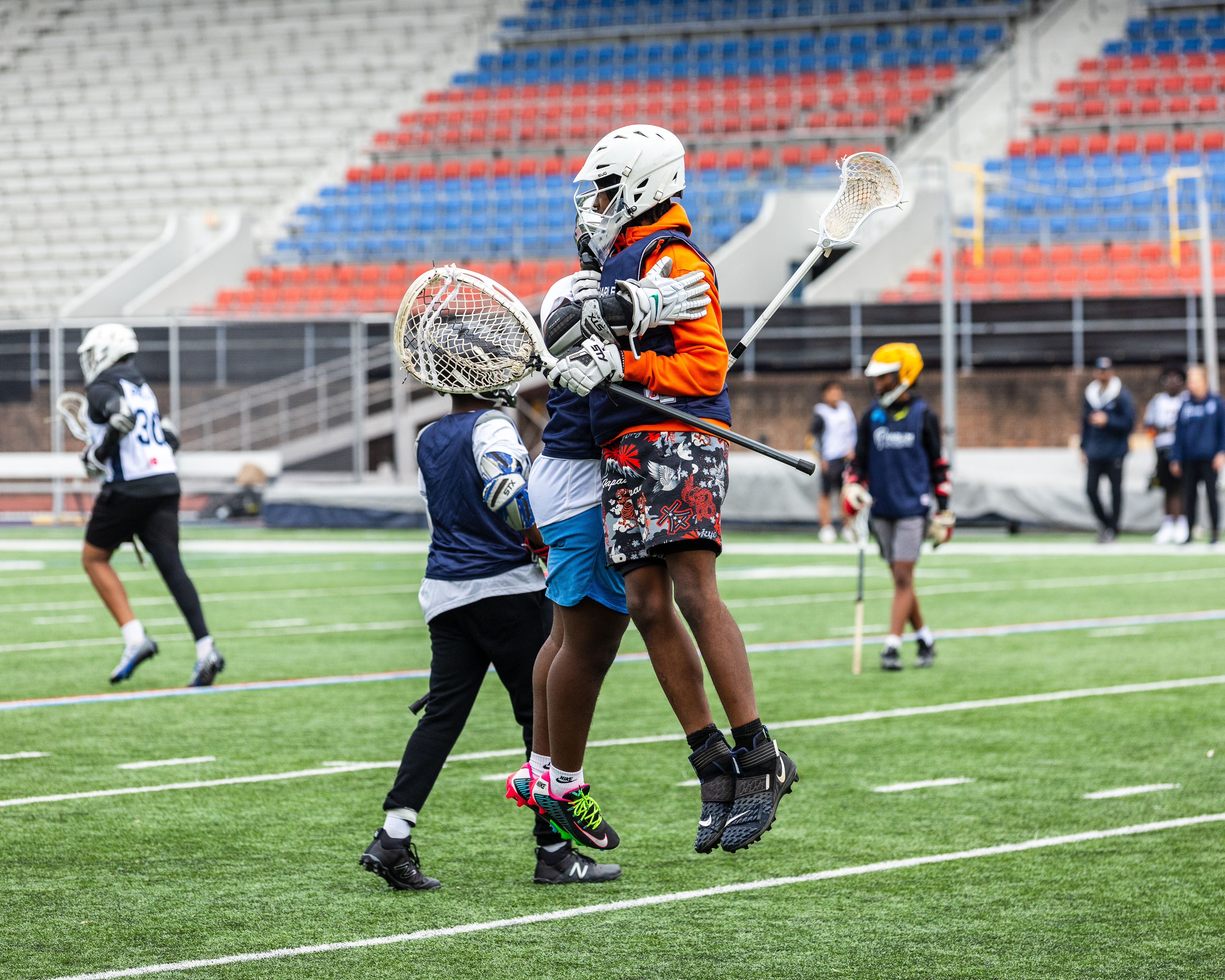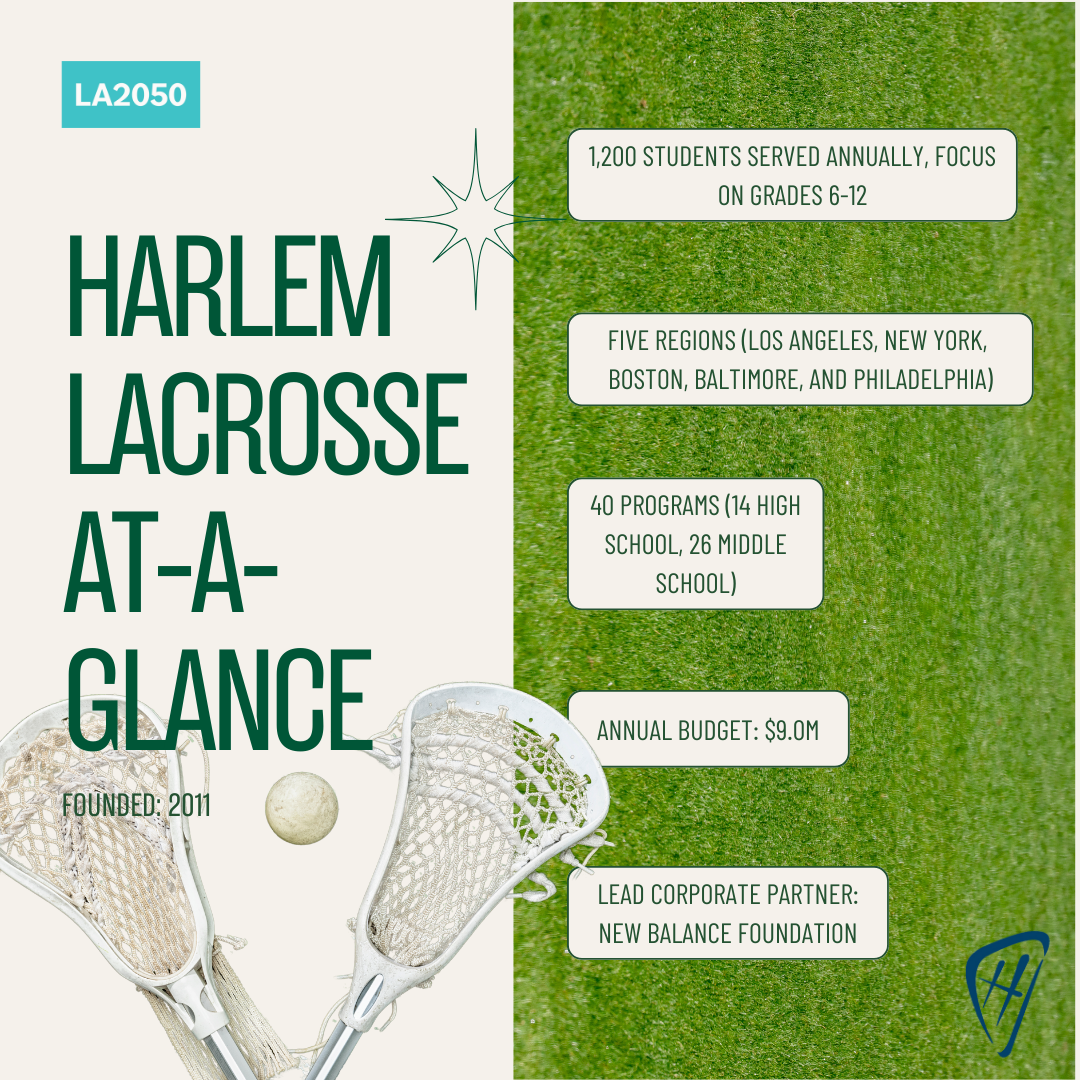LA2050 Blog
We’ve got access to the information that every Angeleno needs to make an impact. Our blog features the latest LA2050 news, announcements, features, happenings, grantee updates, and more.

Harlem Lacrosse: Five Lessons about Nonprofit / Corporate Partnerships
PostedThe leadership of Harlem Lacrosse – a 2019 LA2050 Grants Challenge winner in the PLAY category – approached the Goldhirsh Foundation last year with a quandary: How to refine its approach to the corporate partnerships that help fund Harlem Lacrosse’s impactful work?
We set out on a process to be of service to our past grantee; and by sharing their story and the results of their new efforts, keep the Goldhirsh Foundation and LA2050 social impact communities up to date. Our interviews with a variety of nonprofits and corporate funders to understand both sides of nonprofit-corporate partnerships surfaced several important learnings relevant to a broad swatch of leaders.
To back up: Harlem Lacrosse is a nonprofit organization serving more than 1,200 students in five cities – Baltimore, Boston, Los Angeles, NYC, and Philadelphia. Its school-based program, which combines lacrosse training with various types of academic and enrichment support, has significantly higher rates of high school graduation, college matriculation, and college persistence versus comparison peer groups (i.e. students at the same schools who are not participating in Harlem Lacrosse).
To continue growing this impact, Harlem Lacrosse depends on a mix of funding sources. Historically, about 20% of its revenue has come from corporate partnerships – and these relationships with corporations have also led to internship opportunities for many Harlem Lacrosse graduates.

However, Harlem Lacrosse has also noticed challenges with forging and maintaining these corporate partnerships. Its CEO, Mike Levin, told us these challenges include:
- Processes for vetting and cultivating partnerships can feel inefficient and unclear, sometimes resulting in missed opportunities and wasted time.
- Partnerships are highly customized, resulting in inconsistencies in partnership terms (i.e. varying exchanges of funding and benefits).
We conducted 11 interviews: Six with nonprofits (in addition to Harlem Lacrosse) known for creating robust corporate partnerships, and five with corporate funders who partner extensively with nonprofits. (See footnote at bottom for the 11 listed nonprofits and funders.)
We sought to answer the question: “What makes an effective partnership between a nonprofit and a corporation?” Here are five learnings that are broadly relevant across the sector, one for each step of the partnership process shown below:

#1: In the PROSPECT phase, assess prospects against clear criteria
Our interviews revealed the importance of pre-screening before approaching a prospective partner. As a result, Harlem Lacrosse has now designed a research template for its development team to complete, including questions such as:
- What are the corporation’s philanthropy priorities (e.g., sectors, geographies)?
- What is the corporation’s philanthropy process (e.g., corporate foundation, CSR department)?
- Are there any Harlem Lacrosse connections (e.g., existing donors at the corporation, board members connected to the corporation)?
Harlem Lacrosse anticipates that adding this assessment will increase efficiency, because they will only pursue partnerships with a higher chance of success.
#2: In the CULTIVATE phase, inspire with your work
Our interviews surfaced the idea that the work speaks for itself, and connecting prospective partners to the work is critical. As the Managing Director of Partnerships at one nonprofit shared, “Once a partner has had some direct engagement with our community, they usually want to get more deeply involved.”
For Harlem Lacrosse, this anecdote sparked the idea of involving its existing Alumni Ambassadors in meetings with prospective partners – to relate the personal benefits of having experienced Harlem Lacrosse’s programming.

#3: In the AGREE phase, emphasize the value proposition
Some nonprofits may have the mindset that corporate partners are doing them a favor by providing funding, but our interviews surfaced that these partnerships are incredibly valuable to corporations as well – by providing benefits like positive brand association to customers and opportunities for employees to connect to the community. A senior adviser at an investment firm we interviewed said, “If giving back to communities is done well, that can have beneficial effects inside the firm – like retention, culture, etc.”
For Harlem Lacrosse, this realization has meant subtly shifting their language as they interact with partners and potential partners, to emphasize the value proposition that goes in both directions.
#4: In the LAUNCH phase, standardize as much as possible, with customized elements
For nonprofits managing many corporate partnerships, our interviews shared that it’s important to have some consistencies around funding levels and benefits provided. This enables more equitable partnerships across the organization and provides clarity for the many staff members who interact with each corporate partner. One interviewee said, “We’re trying to figure out the turnkey elements that we can apply to many relationships.”
This learning has generated much discussion at Harlem Lacrosse, as they remain committed to the terms of existing partnerships while also planning to create more consistent partnership terms going forward.
#5: In the STEWARD phase, continue to provide value to the partner in ways that matter to them
Our interviews emphasized that there are consistent themes in what corporations value from nonprofit partnerships: Wanting employee engagement opportunities, clear communication, and an understanding of the impact they’re supporting.
As a result of this understanding, Harlem Lacrosse is making two refinements:
- Creating an organization-wide calendar of all events (e.g., Harlem Bowls, field days) in every region that could be opportunities for corporate engagement.
- Creating a template for sites to easily gather data, photos and anecdotes that populate an annual impact report for each specific partner.

“Collaborating with the Goldhirsh Foundation was invaluable in helping us gain insight into our current process of engaging with corporate partners, including identifying what is working for us at this scale. We identified that much like our model which values depth over breadth, we will be focusing our resources on reinforcing and growing relationships with our key partners over aiming to onboard multiple new partners. These relationships support not only our financial sustainability and alumni internships, but allow us to focus our Development teams’ efforts on cultivating new donors across other verticals as well,” shared CEO Mike Levin.
As Harlem Lacrosse implements these changes in coming months and years, the Goldhirsh Foundation looks forward to continuing to learn more about how partnerships between nonprofits and corporations can create positive impact.

Footnote:
Six interviews with nonprofits known for creating robust corporate partnerships: Big Brothers Big Sisters of Metropolitan Chicago, Big Brothers Big Sisters Independence, Boys & Girls Clubs of Metro Los Angeles, City Year Los Angeles, City Year (former employee of national organization), COOP Careers
Five interviews with corporate funders who partner extensively with nonprofits: New Balance Foundation, The Nike Foundation, PIMCO, Sixth Street, The Starbucks Foundation